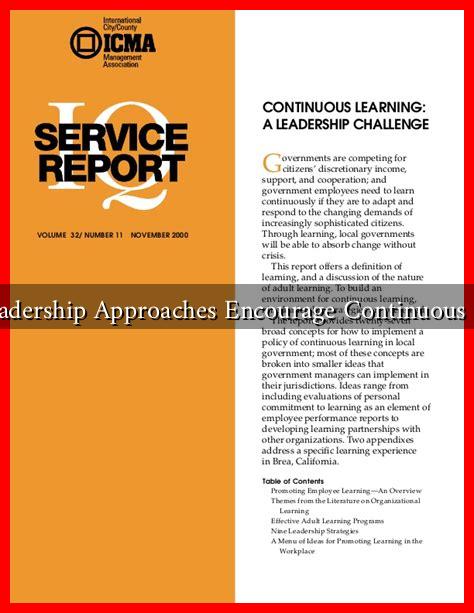-
Table of Contents
What Leadership Approaches Encourage Continuous Learning
In today’s fast-paced and ever-evolving business landscape, continuous learning has become a critical component for organizational success. Leaders play a pivotal role in fostering a culture of learning within their teams. This article explores various leadership approaches that encourage continuous learning, supported by examples, case studies, and relevant statistics.
The Importance of Continuous Learning
Continuous learning is essential for both individual and organizational growth. It enables employees to adapt to changes, innovate, and improve their skills. According to a report by the World Economic Forum, 94% of business leaders believe that employees would stay longer at a company that invests in their career development. This statistic underscores the importance of creating a learning-oriented environment.
Transformational Leadership: Inspiring Growth
Transformational leadership is characterized by the ability to inspire and motivate employees to exceed their own self-interests for the sake of the organization. This approach encourages continuous learning through:
- Vision and Inspiration: Transformational leaders articulate a compelling vision that encourages employees to pursue personal and professional growth.
- Support and Mentorship: They provide guidance and support, fostering an environment where employees feel safe to take risks and learn from failures.
- Recognition of Efforts: Acknowledging and rewarding learning initiatives boosts morale and encourages further development.
For example, Satya Nadella, CEO of Microsoft, transformed the company culture by promoting a “growth mindset.” Under his leadership, Microsoft shifted from a “know-it-all” to a “learn-it-all” culture, resulting in increased innovation and employee satisfaction.
Servant Leadership: Prioritizing Employee Development
Servant leadership focuses on the growth and well-being of employees. This approach encourages continuous learning by:
- Empowering Employees: Servant leaders prioritize the needs of their team members, enabling them to take ownership of their learning journeys.
- Creating a Safe Environment: By fostering trust and collaboration, servant leaders create a safe space for employees to experiment and learn.
- Encouraging Feedback: Regular feedback loops help employees identify areas for improvement and growth.
A notable example of servant leadership is Howard Schultz, former CEO of Starbucks. Schultz emphasized employee training and development, leading to a highly skilled workforce that is committed to the company’s mission.
Adaptive Leadership: Embracing Change
Adaptive leadership is about navigating complex challenges and fostering resilience. This approach encourages continuous learning through:
- Flexibility: Adaptive leaders encourage teams to be flexible and open to new ideas, promoting a culture of experimentation.
- Learning from Experience: They emphasize the importance of learning from both successes and failures, which helps teams adapt to changing circumstances.
- Collaboration: By promoting collaboration across departments, adaptive leaders facilitate knowledge sharing and collective learning.
For instance, during the COVID-19 pandemic, many organizations had to pivot quickly. Leaders who adopted adaptive leadership principles were able to guide their teams through uncertainty, fostering a culture of continuous learning to navigate the crisis.
Conclusion: Cultivating a Learning Culture
In conclusion, effective leadership approaches such as transformational, servant, and adaptive leadership play a crucial role in fostering a culture of continuous learning. By inspiring growth, prioritizing employee development, and embracing change, leaders can create an environment where learning is not just encouraged but celebrated. As organizations continue to face rapid changes, investing in continuous learning will be essential for long-term success.
To learn more about fostering a culture of continuous learning in your organization, consider exploring resources from the Forbes Human Resources Council.

